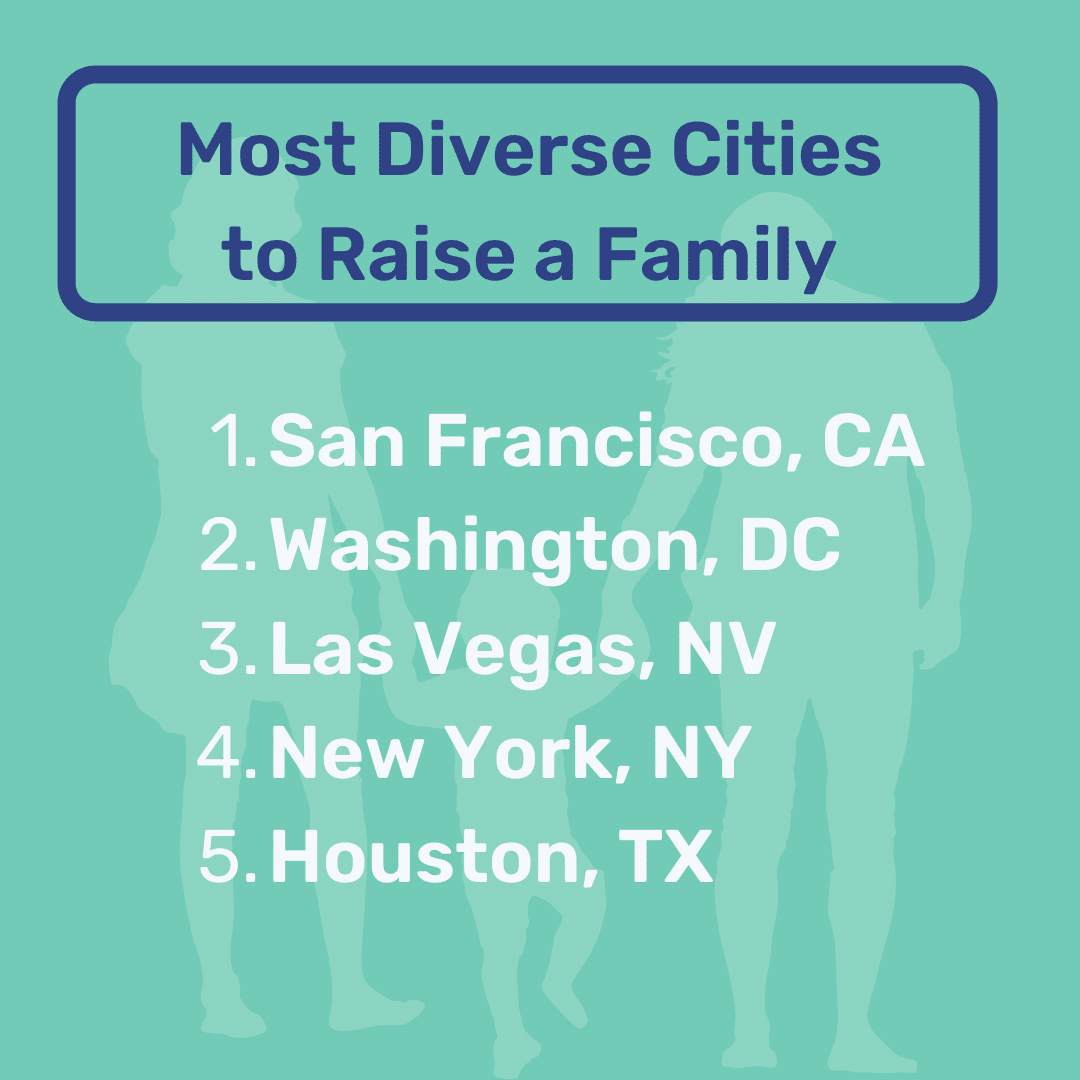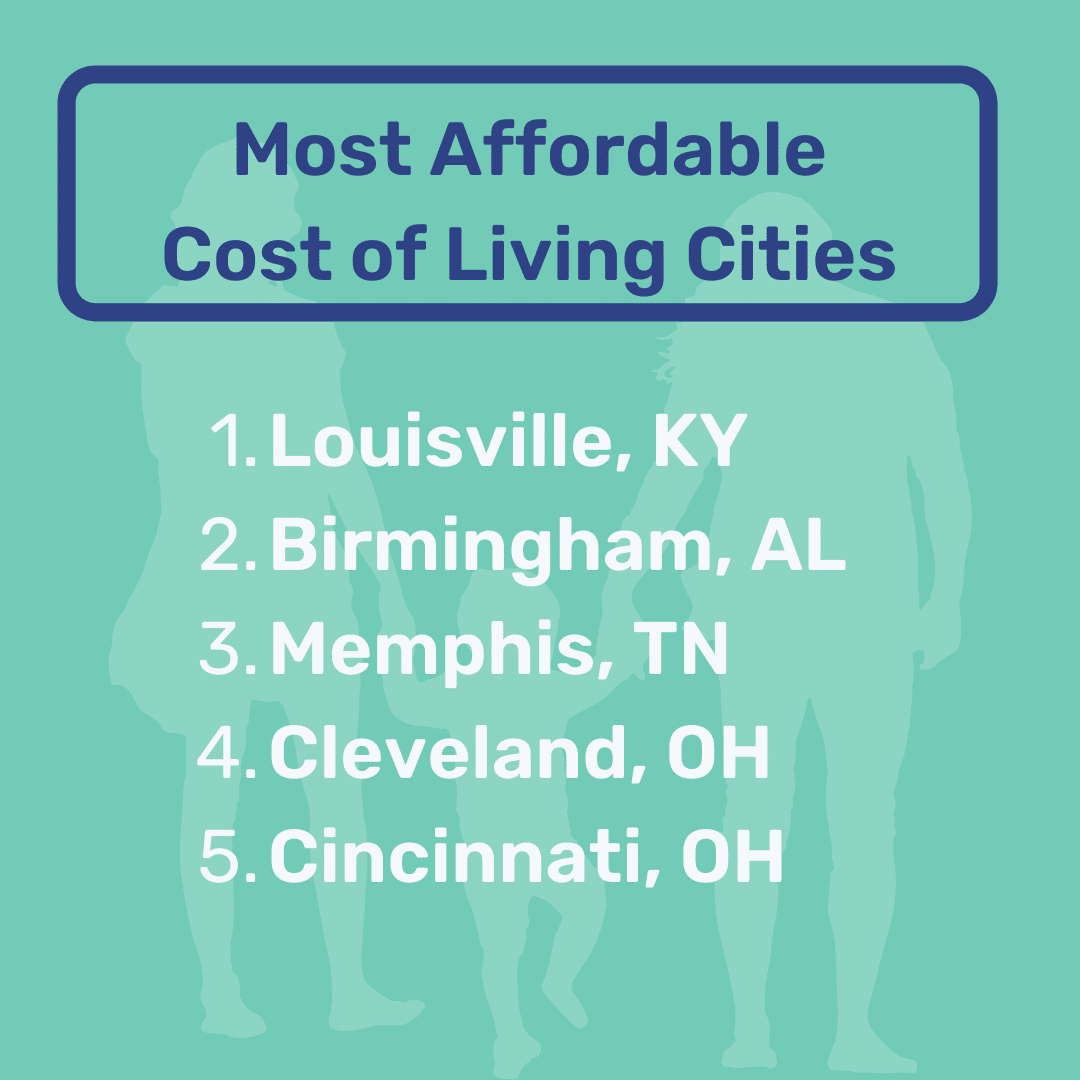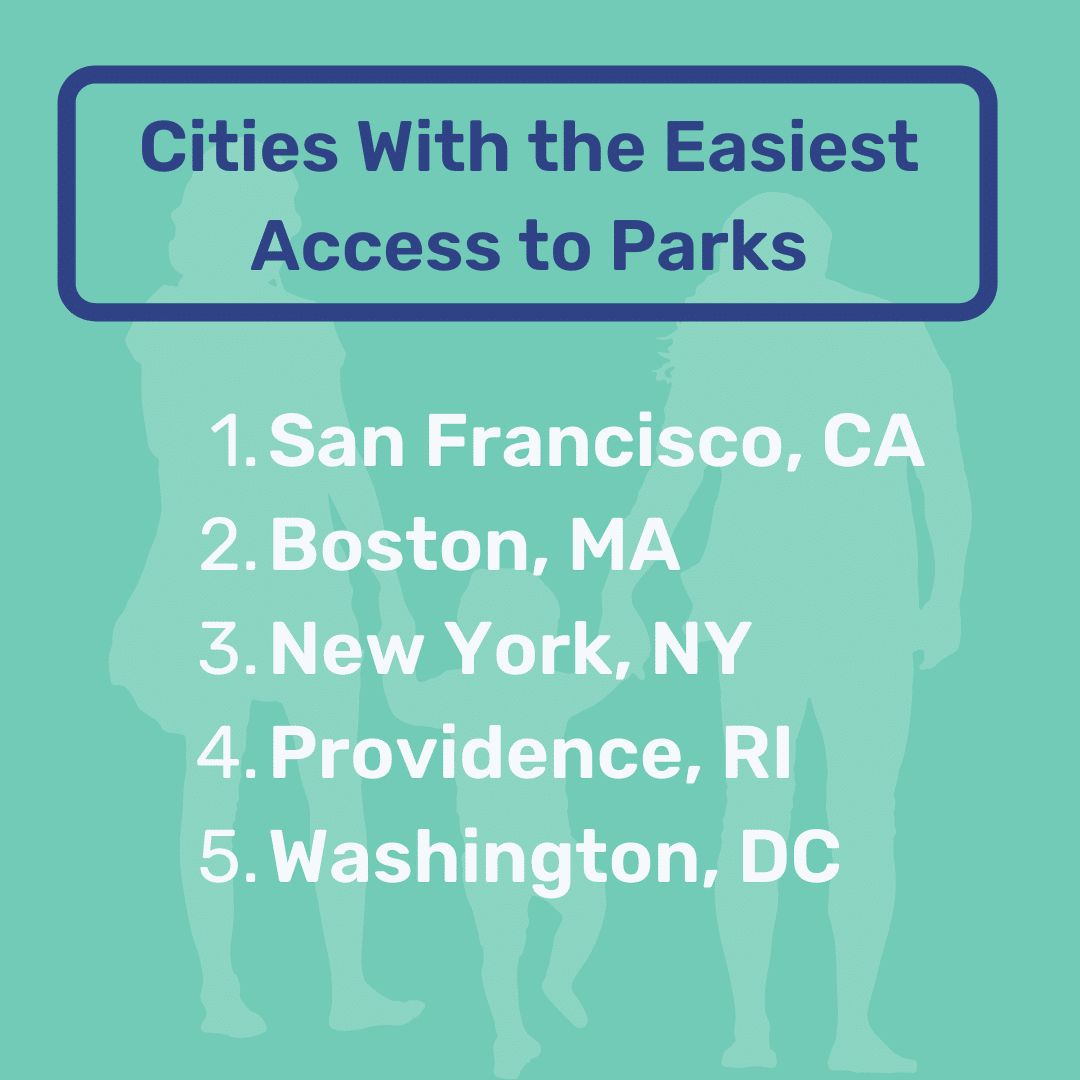
Published
Ranking 50 Cities to Raise a Family | Top 15 Places to Raise a Family | Rankings by Category | 10 Worst Places to Raise a Family | Methodology | FAQ
👩🏻🍼 What is the best state to raise a family? 👨🏽🍼
Pennsylvania and Missouri are the top states for raising a family, each combining top-of-the-line affordability and above-average academics.
Although the pandemic has been hard on all Americans, parents have felt a particular strain. About 71% of families have yet to recover financially from the pandemic, and 80% of parents have struggled to balance work and disrupted schooling, according to our recent study on Americans’ finances.
Now that COVID case numbers, hospitalizations, and restrictions have cooled, many parents are eager to reestablish a stable, prosperous life for their children.
Some cities are well-positioned to assist, with high levels of affordability, better education scores, better recreational opportunities, and more diverse communities, among other benefits.
We examined the 50 largest metros in the U.S. with the goal of finding the best places to raise a family. We took a variety of economic, educational, social, and recreational factors into consideration:
- Education:
- 5x: Graduation rates
- 3x: Literacy score
- 1x: Fourth grade reading and math scores
- 1x: Eighth grade reading and math scores
- Economic:
- 4x: Cost of living
- 3x: Rent affordability
- 3x: Housing affordability
- 2x: Affordability of child care (newborns and 4-year-olds)
- 2x: Unemployment rate
- Social:
- 3x: Diversity
- 3x: Poverty rate
- 2x: Violent crime rate
- Recreational:
- 3x: Access to parks
- 1x: Amount of park land
👨👩👧👦 Best Family Cities Statistics
- Hartford, Conn., is the best city to raise a family, combining a high number of libraries with low crime and poverty rates. Jump to section 👇
- Providence, R.I., excels academically, with some of the best reading and math scores. It also ranks No. 1 in our literacy metric. 👇
- Salt Lake City ranks No. 1 in two factors we analyzed: It has the lowest state poverty rate (8.9%) and the lowest unemployment rate (2.1%) in our study. 👇
- Pittsburgh is the most affordable city for housing, with the lowest house-price-to-income ratio and the lowest rent-price-to-income ratio. 👇
- Oklahoma City is the best overall city for raising children affordably. It ranks No. 1 for cheapest place to raise a 4-year-old and No. 2 for cheapest place to raise a newborn. 👇
- Norfolk, Va., is the safest city in our study. Its rate of 138 violent crimes per 100,000 residents is much lower than the average city in our study (878 per 100,000). 👇
- San Francisco ranks No. 1 for the most diverse city in our study.
- San Franciscans also have the easiest access to parks on average, with 99.9% of the population living within a 10-minute walk of a park. 👇
- Louisville, Ky., has the lowest cost of living of any city. Goods here have a regional price parity of 91.9, cheaper than the national average of 100. 👇
Ranking the 50 Best Places to Raise a Family
| Rank | City | Newborn Care Cost | House-Price-to-Income Ratio | Relative Cost of Goods* | High School Graduation Rate (by State) | Combined Reading and Math Scores (by State)** | Diversity Score*** | Violent Crime Rate per 100,000 |
|---|---|---|---|---|---|---|---|---|
| - | National Average | 18.2% | 6.5 | 100 | 86% | 1,024 | 1.17 | 878 |
| 1 | Hartford, CT | 19.7% | 4.5 | 102.9 | 89% | 1,026 | 1.03 | 199 |
| 2 | Milwaukee, WI | 19.7% | 4.2 | 95.9 | 90% | 1,066 | 1.04 | 1,597 |
| 3 | Providence, RI | 19.4% | 6.9 | 101.2 | 84% | 1,076 | 0.87 | 283 |
| 4 | Salt Lake City, UT | 12.9% | 9.7 | 97.7 | 87% | 1,051 | 0.89 | 367 |
| 5 | Philadelphia, PA | 15.8% | 4.5 | 102.3 | 87% | 1,028 | 1.11 | 948 |
| 6 | St. Louis, MO | 15.3% | 3.7 | 95.7 | 90% | 1,029 | 0.83 | 2,082 |
| 7 | Kansas City, MO | 14.5% | 4.6 | 94.7 | 90% | 1,029 | 0.93 | 1,724 |
| 8 | Pittsburgh, PA | 19.1% | 3.2 | 95.7 | 87% | 1,028 | 0.59 | 656 |
| 9 | Oklahoma City, OK | 10.5% | 3.8 | 93.8 | 85% | 1,060 | 1.17 | 787 |
| 10 | Chicago, IL | 18.5% | 4.3 | 104.8 | 86% | 1,067 | 1.23 | 1,099 |
| 11 | Raleigh, NC | 12.0% | 6.7 | 95.7 | 87% | 1,045 | 1.13 | 792 |
| 12 | Richmond, VA | 19.8% | 5.1 | 95.4 | 88% | 946 | 1.09 | 228 |
| 13 | Minneapolis, MN | 19.4% | 5.3 | 103.2 | 84% | 1,012 | 0.9 | 1,101 |
| 14 | Birmingham, AL | 10.1% | 4.1 | 92.6 | 92% | 991 | 0.93 | 1,577 |
| 15 | Houston, TX | 13.5% | 4.7 | 100.1 | 90% | 1,030 | 1.32 | 1,095 |
| 16 | Dallas, TX | 12.8% | 5.7 | 105.1 | 90% | 1,030 | 1.29 | 775 |
| 17 | Austin, TX | 11.5% | 8.6 | 101.8 | 90% | 1,030 | 1.16 | 415 |
| 18 | Cincinnati, OH | 14.6% | 4.1 | 93.5 | 82% | 991 | 0.74 | 947 |
| 19 | Baltimore, MD | 18.3% | 5.3 | 105.4 | 87% | 1,044 | 1.13 | 2,027 |
| 20 | Nashville, TN | 12.8% | 6.5 | 97 | 91% | 1,058 | 0.92 | 1,138 |
| 21 | Norfolk, VA | 20.5% | 5.7 | 96.2 | 88% | 946 | 1.14 | 138 |
| 22 | Louisville, KY | 10.5% | 4.1 | 91.9 | 91% | 1,001 | 0.81 | 647 |
| 23 | Columbus, OH | 14.5% | 4.9 | 94.2 | 82% | 991 | 0.92 | 513 |
| 24 | Boston, MA | 22.4% | 7.2 | 110.2 | 88% | 1,055 | 1 | 669 |
| 25 | Atlanta, GA | 12.0% | 5.9 | 98.2 | 82% | 1,025 | 1.23 | 936 |
| 26 | Charlotte, NC | 14.4% | 6.1 | 94.6 | 87% | 1,045 | 1.15 | 663 |
| 27 | Indianapolis, IN | 19.9% | 4.1 | 94.7 | 87% | 1,042 | 0.93 | 1,334 |
| 28 | Jacksonville, FL | 14.7% | 5.9 | 96.3 | 87% | 1,008 | 1.08 | 631 |
| 29 | Memphis, TN | 16.2% | 4.2 | 92.7 | 91% | 1,058 | 1.04 | 2,003 |
| 30 | San Jose, CA | 13.1% | 13 | 112.1 | 85% | 1,013 | 1.31 | 404 |
| 31 | San Antonio, TX | 15.2% | 6.2 | 97.9 | 90% | 1,030 | 1.05 | 708 |
| 32 | Tampa, FL | 16.2% | 6.4 | 99.1 | 87% | 1,008 | 1.08 | 464 |
| 33 | Cleveland, OH | 16.9% | 3.4 | 93 | 82% | 991 | 0.92 | 1,557 |
| 34 | Denver, CO | 18.4% | 8.6 | 107.3 | 81% | 1,057 | 1.04 | 676 |
| 35 | Las Vegas, NV | 18.7% | 7.9 | 97.2 | 84% | 1,021 | 1.36 | 619 |
| 36 | Buffalo, NY | 26.1% | 4.1 | 95.7 | 83% | 1,024 | 0.82 | 1,019 |
| 37 | Orlando, FL | 15.1% | 7.2 | 98.7 | 87% | 1,008 | 1.25 | 744 |
| 38 | Seattle, WA | 16.0% | 9.1 | 112 | 81% | 1,011 | 1.16 | 633 |
| 39 | New Orleans, LA | 14.2% | 4.4 | 96.9 | 80% | 1,010 | 1.12 | 1,121 |
| 40 | San Francisco, CA | 15.3% | 12.5 | 117.4 | 85% | 1,013 | 1.4 | 715 |
| 41 | Detroit, MI | 17.3% | 3.9 | 97.1 | 81% | 1,011 | 0.99 | 2,057 |
| 42 | New York, NY | 18.8% | 7 | 115.5 | 83% | 1,024 | 1.34 | 539 |
| 43 | Portland, OR | 17.6% | 8.7 | 105.7 | 80% | 1,022 | 0.93 | 516 |
| 44 | Miami, FL | 15.7% | 6.3 | 110 | 87% | 1,008 | 1.21 | 721 |
| 45 | Sacramento, CA | 22.4% | 9.4 | 106.1 | 85% | 1,013 | 1.3 | 676 |
| 46 | Phoenix, AZ | 16.3% | 8.4 | 102.6 | 78% | 1,024 | 1.14 | 761 |
| 47 | Washington DC | 22.8% | 6.9 | 111.5 | 69% | 1,025 | 1.36 | 949 |
| 48 | San Diego, CA | 20.6% | 13 | 113.4 | 85% | 1,013 | 1.26 | 367 |
| 49 | Los Angeles, CA | 22.2% | 12.6 | 111.9 | 85% | 1,013 | 1.3 | 761 |
| 50 | Riverside, CA | 24.8% | 12 | 103.7 | 85% | 1,013 | 1.2 | 509 |
The 15 Best Places to Raise a Family

American families have a lot of solid options when deciding where to put down roots. But some cities check so many boxes that they climb to the top of the pack. The top 15 cities on our list stand out because of:
- Affordable child care: Raising a newborn in the top 15 cities costs parents less compared to other metros. The average annual cost of a newborn is 16% of the local median household income in the top 15 cities, cheaper than the 18.2% average among all 50 cities we analyzed.
- Lower house prices: Buying a house is less expensive for parents living in the top 15 cities. The median house price is about 5x the local median household income in these cities compared to an average of 6.5x among all cities we studied.
- High literacy: The top 15 cities are especially friendly to those who love to read. They have an average book score of 61 out of 100 — which factors in literacy rates and the number of bookstores and libraries, among other metrics. That’s better than the overall average score of 53.
- Recreational options: It’s easy to find outdoor activities in the top 15 cities. About 80.3% of these cities’ residents live within a 10-minute walk of a park. Across all 50 metros, that percentage is only 73.9%.
1. Hartford, Connecticut
👮 Safe and Sound
Hartford is one of the safest cities to raise a family. Its rate of violent crime of 199 per 100,000 people is 77% lower than the average city we analyzed (878 per 100,000 people).
In addition to the second-lowest violent crime rate on our list, Hartford earns high marks for literacy. The Connecticut capital finished No. 2 in our recent study on the best book places, thanks in part to having the most libraries per capita out of the nation’s 50 largest metros.
Hartford is also in better shape economically than most of the cities we examined. Connecticut has the ninth-lowest poverty rate in our study at 10%, better than the national average of 12.2% among the places we analyzed.
2. Milwaukee, Wisconsin
💸 Little Spent on Rent
Renting is relatively affordable in Milwaukee. The median monthly rent costs about 1.5% of the area’s median household income annually, a fraction of the 2% average among all cities in our study.
In addition to affordable living, Milwaukee is a great spot for parents who value education. Wisconsin ranks No. 3 on our list for proficiency in reading and math, according to the National Assessment of Educational Progress (NAEP), which measures reading and math skills for fourth and eighth graders.
Wisconsin also has one of the highest graduation rates of any state at 90%. Only six states beat that mark, according to the National Center for Education Statistics.
3. Providence, Rhode Island
👩🎓 Top of Its Class
Rhode Island has the best average math and reading scores among fourth and eighth graders. The state’s combined NAEP scores of 1,076 are well above the average of 1,024 among the places we studied.
Providence has put its standout reading scores to good use: Using different factors, we recently ranked it as the No. 1 city for book-lovers in the U.S., thanks to a high number of libraries and a literacy rate that’s above average.
Providence is also one of the safest cities to raise a family. According to the most recently available data, the city reports 283 violent crimes per 100,000 residents — way lower than the average rate of 878 per 100,000 on our list. Only three of the 50 cities we ranked performed better than Providence in this metric.
4. Salt Lake City, Utah
🔥 The Hottest Job Market
Salt Lake City has the lowest unemployment rate of any city in our analysis. At 2.1%, unemployment here is nearly half of the national average (3.8%).
In addition to being the best city for employment, Salt Lake City has the lowest poverty rate of any place we examined. The state’s poverty rate is 8.9%, better than the average in our study of 12.2%. (Given its strong economics, it’s no wonder Salt Lake City is also one of the best places to start a business.)
With two first-place rankings in the categories above, Salt Lake City had a chance to place higher on our list, but a few subpar metrics brought it down: The city has the sixth-highest house-price-to-income ratio and the seventh-worst diversity score in our rankings.
5. Philadelphia, Pennsylvania
🌳 A Place for Parks
Philadelphia has a wealth of recreation options, as 94.7% of residents live within a 10-minute walk of a park — compared to 73.9% in the average city we reviewed.
Philadelphia can take pride in providing plenty of recreation opportunities for residents. The city devotes 13% of its land to recreational purposes, while the average city in our study devotes just 11%. (Admittedly, a lack of funding could undercut this asset in the future.)
The city is also a convenient place for parents with infants. Raising a newborn in Philadelphia costs about 15.8% of median household income compared to the average city in our study, where parents spend 18.2% of their income. These factors and others make Philadelphia the best place to raise a family in Pennsylvania.
6. St. Louis, Missouri
🏠 An Affordable Abode
Out of 50 cities, St. Louis ranks No. 3 for housing affordability and No. 4 for renting affordability.
St. Louis is the best place to raise a family in Missouri, with housing prices that are hard to beat. A household making the area’s median income can purchase a house for about 3.7 years’ worth of the income, much cheaper than the average house-price-to-income ratio of cities in our study (6.5).
Renting in St. Louis is just as convenient. It costs about 1.5% per month of the median annual household income to afford an apartment in St. Louis, while residents in the average city in our study pay 2% per month.
When it comes to education, Missouri’s high school graduation rate of 90% puts it in the top 10 among all states (tied for seventh).
7. Kansas City, Missouri
☃️ A Cool Cost of Living
Kansas City is a solid city for parents on a budget. With a low cost of living, goods in Kansas City have a regional price parity of 94.7 compared to 100 nationally.
Kansas City’s low cost of living translates to other perks for parents’ pocketbooks. The city ranks seventh in our study for cost to raise a 4-year-old, running parents 10.1% of their median household income each year as opposed to 14% in the average city.
Kansas City also ranks in the better half of our study for cost to raise a newborn, with parents spending 14.5% of the area’s median income annually compared to 18.2% in the typical city we studied.
8. Pittsburgh, Pennsylvania
👑 The King of Affordable Housing
No city tops Pittsburgh in terms of cheap housing costs. The Steel City ranks No. 1 for housing affordability and No. 1 for renting affordability.
The median house price in Pittsburgh is worth about 3.2 years of the area’s median household income annually. That’s more than twice as affordable as the average city in our study, which carries a house-price-to-income ratio of 6.5.
Rent is equally affordable. One month’s rent in Pittsburgh will run parents about 1.4% of their annual income, better than the 2% paid by residents of the typical city we analyzed.
Pittsburgh also performs above average on literacy. The city earned a score of 66 in our recent best book places study, 25% higher than the average metro’s score of 53.
Pittsburgh would have ranked higher on our list overall but was hurt by having the third-highest unemployment rate and the worst diversity score of the cities we examined.
9. Oklahoma City, Oklahoma
👌 More Than Just OK
Oklahoma City is the cheapest metro in the country for raising a 4-year-old, costing parents just 8.1% of the area’s median household income compared to 14% in the average city.
Parents in Oklahoma City see significant savings earlier in their child’s life as well. The city ranks second for cheapest metro to raise a newborn, costing 10.5% of the median household income in the city annually, better than the 18.2% annual cost in the average city we reviewed.
Oklahoma City has the sixth-cheapest cost of living out of the 50 cities on our list. Goods in OKC have a regional price parity of 93.8, lower than the national average of 100.
10. Chicago, Illinois
🧠 Sharp Students
Chicago ranks No. 2 for the best combined reading and math scores. Taking into account fourth and eighth graders, the state’s proficiency scores add up to 1,067, while the average state in our study scores 1,024.
Perks for parents continue outside of the classroom: Recreation is relatively accessible in Chicago. About 98.2% of Chicago residents live within a 10-minute walk of a park compared to 73.9% in the average city.
Chicago also stands out as a city where communities of all types thrive. The city’s diversity score of 1.23 is the 12th-highest on our list.
11. Raleigh, North Carolina
👷 Putting in the Work
Raleigh’s unemployment rate of 2.9% is nearly a full percentage point lower than the national average (3.8%).
When it comes to child care, raising kids in Raleigh won’t break the bank. The city ranks sixth in affordability for raising a newborn, which costs about 12% of the local median household income each year, well below the average of 18.2% in our study.
The same goes for 4-year-olds, where Raleigh ranks 10th in affordability. The annual cost of a 4-year-old’s child care is 10.3% of the median household income in Raleigh, compared to 14% in the average city we reviewed. In all, the savings from living here help make Raleigh the best place to raise a family in North Carolina.
12. Richmond, Virginia
🏰 A Sense of Security
Richmond has the third-lowest rate of violent crime on our list. Its rate of 228 violent crimes per 100,000 residents is significantly lower than average (878 per 100,000), according to the most recent year of available data.
Aside from being safer, Richmond residents seem to fare better financially than residents of the average city. Virginia’s poverty rate of 9.9% is the seventh-lowest on our list and an improvement over our study’s average rate of 12.2%.
Richmond conveniently has a cheap cost of living, too. Goods in Richmond have a regional price parity of 95.4, cheaper than the national average of 100.
13. Minneapolis, Minnesota
💐 A Flourishing Economy
Minneapolis residents are doing well financially compared to other cities on our list. Minnesota has the second-lowest poverty rate in our study (9% vs. the average in our study of 12.2%).
Minneapolis also has healthy employment numbers. The city’s unemployment rate is 2.5%, better than the national average of 3.8% and good enough to be tied for fifth on our list.
Minneapolis also prioritizes activities for families. The city devotes 15% of its land to recreational purposes, while the average city devotes just 11%. The Trust for Park Land recently named Minneapolis and nearby St. Paul as top-five cities for park systems.
14. Birmingham, Alabama
👶 The Best for Babies
Birmingham is the best metro in the country for raising a newborn affordably. The annual cost of bringing up a newborn here is 10.1% of the local median household income each year, almost half the average cost of 18.2% among cities we studied.
For Birmingham parents, child care savings don’t stop at infancy. The city ranks No. 3 in affordability of raising a 4-year-old, as parents here spend 8.8% of the local median household income each year compared to 14% in the typical city we analyzed.
Birmingham also benefits from Alabama’s status as a state tied for first in the country for its high school graduation rate of 92%. Given its upside, Birmingham would have ranked higher on our list had it not been in a state with a high poverty rate and the lowest average math scores.
15. Houston, Texas
🌈 A Spectrum of Citizens
Houston has the fifth-best diversity score of any city we reviewed at 1.32 — a 13% improvement over the average of 1.17 among all cities in our study.
Houston is one of the more affordable cities for raising children. The annual cost of raising a 4-year-old here is 10.2% of the local median household income, while residents in the typical city we reviewed spend 14% each year.
Later in life, Houston students have better-than-average odds of graduating from high school, thanks to a statewide graduation rate of 90% — making it one of the top 10 states in that metric. Altogether, Houston beats out other cities as the best place to raise a family in Texas.
Data Details: Top 5 Rankings by Category
 |  |
 |  |
 |  |
The 10 Worst Places to Raise a Family
After running the numbers, the data reveals that none of the cities on our list are truly “bad” places to raise a family. Every city scores well in at least a few metrics. Some cities, however, still don’t have quite as many perks as others, and these 10 struggled to rise higher in our rankings:
- Riverside, California
- Los Angeles, California
- San Diego, California
- Washington, D.C.
- Phoenix, Arizona
- Sacramento, California
- Miami, Florida
- Portland, Oregon
- New York, New York
- Detroit, Michigan
These 10 cities stick out because of:
- A high cost of living: Goods in the bottom 10 cities have a regional price parity of 107.7, meaning they’re more expensive than the national average of 100.
- Expensive rent: The bottom 10 cities have a median rent-price-to-income rate of 2.4% each month, while the average rate among all cities in our study is 2%.
- Lower graduation rates: These 10 cities tend to be in states with lagging high school graduation rates. Together, their states average an 82% graduation rate, a few notches below the national average of 86%.
- Modest literacy scores: The bottom 10 cities received an average score of 47 in our best book places study — based on factors such as literacy rates and the prevalence of libraries and bookstores. That’s lower than the overall average of 53 in that study.
The data led to Riverside finding itself in last place out of the country’s 50 most-populous metros. The city is the second-most expensive for raising a newborn — costing 24.8% of local median household income annually — and the third-most expensive for raising a 4-year-old (16.8%).
Affordable housing in Riverside is also difficult to come by, as it has the third-worst rent-to-income ratio (2.8%) and fifth-worst house-price-to-income ratio (12).
It’s not all bad news for the Southern California locale. Riverside has the 10th-lowest violent crime rate on our list (509 per 100,000 residents), edging out a few other California cities in that metric.
Methodology
To determine the best places to raise a family, Real Estate Witch evaluated 17 metrics, with the following weights:
- High school graduation rate: 12.5%
- Cost of living (relative cost of consumer goods): 10%
- Diversity index: 7.5%
- Poverty rate: 7.5%
- Percent of residents within a 10-minute walk of a park: 7.5%
- Book city score (general literacy): 7.5%
- Rent-to-income ratio: 7.5%
- House-price-to-income ratio: 7.5%
- Unemployment rate: 5%
- Violent crime rate: 5%
- Newborn child care costs as percent of income: 5%
- 4-year-old child care costs as percent of income: 5%
- Fourth grade reading scores: 2.5%
- Fourth grade math scores; 2.5%
- Eighth grade reading scores: 2.5%
- Eighth grade math scores: 2.5%
- Percent of city land used for recreation: 2.5%
The data for each point was normalized, weighted, and combined to calculate the overall score.
Data points were attributed to metropolitan areas as much as possible. For some data points, statewide data was used. For others, data attributed to the largest city in the metropolitan area was used.
Data sources for this study include the National Center for Education Statistics, the National Assessment of Educational Progress, the FBI, individual city and metro police departments, the Bureau of Labor Statistics, Zillow, the Department of Housing and Urban Development, the Trust for Public Land, the Economic Policy Institute, TalkPoverty, the U.S. Census, the National Equity Atlas, Libraries.org, and Yelp.
About Real Estate Witch
You shouldn’t need a crystal ball or magical powers to understand real estate. Since 2016, Real Estate Witch has demystified real estate through in-depth guides, honest company reviews, and data-driven research. In 2020, Real Estate Witch was acquired by Clever Real Estate, a free agent-matching service that has helped consumers save more than $82 million on realtor fees. Real Estate Witch’s research has been featured in CNBC, Yahoo! Finance, Chicago Tribune, Black Enterprise, and more.
More Research From Real Estate Witch
How to Choose a Realtor (Expert Secrets): Although most people commit to the first real estate agent they interview, we recommend comparing several options to find the best fit for you.
Companies That Buy Houses for Cash in 2022: “We Buy Houses” companies and iBuyers pay cash for houses. But are their deals fair? We found the facts you should consider.
U.S. Rent Prices Are Rising 4x Faster Than Income: It’s not just home prices. Rental rates are rising to record highs across the U.S. Our data reveals where rent prices are outpacing income at the highest rate.
Frequently Asked Questions About the Best Places to Raise a Family
What is the best U.S. state for raising a family?
Pennsylvania and Missouri stand out as the best states to raise a family in 2022. Both states have cities that combine affordability with impressive educational performance. Learn more.
What is the best place to raise a family in the U.S.?
The best city to raise a family in the U.S. is Hartford, Conn. The city has some of the lowest violent crime and poverty rates in the country. Learn more.
What's the safest state to raise a family?
Virginia is the safest state for raising a family. Of the nation's 50 largest metro areas, the Norfolk-Virginia Beach metro has the lowest violent crime rate, and Richmond has the third-lowest violent crime rate. Learn more.
What's the best place to raise a family in Florida?
Jacksonville is the best city for raising a family in Florida. Out of Florida's four biggest metro areas, Jacksonville has the lowest cost of living, cheapest housing, and highest share of space devoted to recreation. Learn more.

Leave a Reply